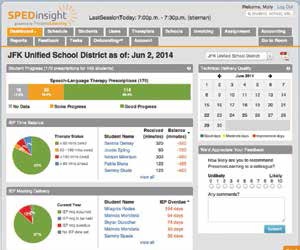GAME CHANGERS: REMOTE CONTROL

Most stories you hear about distance education setups involve displaced students patched into the schoolroom virtually, via Web or Robotcam. At Rocky Mount Prep Charter School in eastern North Carolina, students receiving speech therapy sessions have the teachers beamed in instead.
Serving 1,236 students in grades K-12, the tuition-free public charter school has employed methodology based on Rocketship Elementary and Carpe Diem High School’s blended learning models. The daily instruction model enables students from kindergarten to 12th grade to spend part of their day completing assignments and researching subject areas on the computer.
One aspect that was not working well about three years ago was the school’s special education services. There was a local shortage of speech-language pathologists, which resulted in inconsistent therapy sessions and parents concerned that their children were not getting the help they needed. “Being in a semi-rural part of the state, we found we were having a number of scheduling conflicts,” says Doug Haynes, CEO of Rocky Mount Prep. “Sometimes the therapist would get stuck at another site, sometimes parents were unable to make in-person meetings. It was messy.”
In 2012, Haynes discovered an online speech therapy solution from a new company called PresenceLearning. The setup is very similar to traditional speech or occupational therapy
3 KEY METRICS EVERY SPED DIRECTOR NEEDS TO KNOW
Are you able to easily answer parents’ questions about their child’s progress toward IEP goals? Do you know why a student missed a therapy session? Do you know how many IEP meetings are overdue, and for whom? Can you report, without a lot of deep digging, how many of your students are making good progress, and how many are not? Do you have the facts at your fingertips that allow you to make decisions about your special education program and adjust?
You can answer all of these questions by having a solid grasp on three key metrics:
Tools and ideas to transform education. Sign up below.
Student progress: Know how many of your students receiving services are progressing toward their goals across a school or a district. How many have achieved their goals? How many are making good progress? What about some progress? For whom do you need more information?
IEP time balance: Are your students on track or are some missing too much therapy time to complete their goals by the end of the year?
IEP meeting delivery: Are IEP meetings taking place on time? Are they scheduled? Overdue? sessions except that, instead of sitting in the same room, students and therapists interact via live videoconferencing. Speech-language pathologists (SLPs) and occupational therapists (OTs) work with kids face-to-face in real time, using established best practices and assisted by PresenceLearning’s online therapy tools. The company handles recruitment and management of SLPs and OTs, and ensures that they are properly licensed and/or credentialed in the school district’s state. Rocky Mount provides an onsite paraprofessional to facilitate logistics and other needs during therapy sessions.
Screenshots from PresenceLearning.


The school started using the program with around 30 students and now uses online speech therapy with nearly 50 students, mostly in grades K-5 and some in middle school. PresenceLearning’s online SLPs conduct evaluations, deliver therapy sessions, and complete documentation for each speech therapy case, allowing students to receive consistent, high-quality therapy and allowing Rocky Mount to stay in compliance with the Individuals with Disabilities Education Act (IDEA).
PresenceLearning also offers data features and functions available in traditional learning management systems. The company’s SPED Insight administrator dashboard offers superintendents, special education directors, and supervisors of related services delivery a top-level graphical view of data summarizing progress on IEP goals, delivery of therapy time owed, and timely completion of mandated IEP meetings.
While Haynes says there was some slight hesitation on the part of parents and faculty at first, the results have proved the program a success. “Kids that were ‘in speech’ tended to stay ‘in speech’,” says Haynes. “Now we see a steady stream of kids cycling out of the program, which is ultimately the idea.”
WHAT ARE THE BENEFITS OF ONLINE SPEECH THERAPY/OCCUPATIONAL THERAPY FOR SCHOOLS?
Flexible access to top-notch SLPs and OTs: Schools are no longer limited to locally-based SLPs and OTs, but can draw from a large nationwide network of highly qualified, certified therapists, available whenever needed. Schools also get better access to specialists and to culturally and linguistically diverse therapists.
Better outcomes: The combination of greater access to high-quality SLPs and OTs, improved availability and scheduling flexibility, and PresenceLearning’s best-in-class online therapy tools all lead to better results. Positive outcomes are validated by a large body of research.
Happier students and parents: Having grown up with digital technology, kids love the online video interactions and computerized games and activities. Better outcomes, happier kids, and improved reporting and communications, in turn, lead to very high parent satisfaction levels.
Major time savings: PresenceLearning relieves schools of a huge administrative headache and expense. Districts no longer have to recruit, screen, contract, train, and manage SLPs and OTs, pay transportation expenses, or worry about interruptions in therapy when SLPs or OTs are absent, on leave, or no longer with the district.
Better scheduling, tracking, reporting, and auditing: PresenceLearning’s integrated set of tools streamlines these essential functions.
Easy to set up and use: All that’s required is a computer with an Internet connection, a Webcam, and an audio headset (the company will provide the Webcam and headset for free if needed). The program is acknowledged and accepted by leading agencies, such as the Mayo Clinic and the American Speech-Language-Hearing Association (ASHA).
